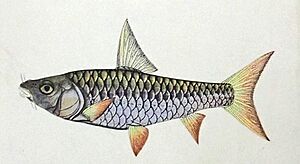Tor mahseer facts for kids
Quick facts for kids Tor mahseer |
|
|---|---|
 |
|
| Original illustration of Tor tor by Haludar 1822 | |
| Conservation status | |
| Scientific classification | |
| Synonyms | |
|
The Tor tor, also called the tor mahseer or tor barb, is a type of fish that lives in rivers. It belongs to the cyprinid family, which includes carps and minnows. You can find this fish in fast-moving rivers and streams with rocky bottoms. It lives in countries like India, Bangladesh, Bhutan, Nepal, and Pakistan.
This fish is important for people. It is caught for food and is also popular for sport fishing. Sadly, the number of Tor tor fish is decreasing quickly in many places. This is happening because of things like pollution, too much fishing, and the building of dams.
The Tor tor can grow quite large. It reaches about 36 centimeters (14 inches) when it's ready to have babies. Some have been seen as long as 150 centimeters (5 feet), and they can even reach 200 centimeters (6.5 feet). This fish has very big scales, with each one growing up to 10 centimeters (4 inches) long. These scales act like armor for the fish.
In some parts of India, the Tor tor is a special fish. The main type found in Central India is the state fish of Madhya Pradesh. A different kind, called Tor mosal mahanadicus, is the state fish of Odisha.
Where Tor Mahseer Live
The giant red-finned mahseer, including the Tor tor, is built for feeding near the bottom of rivers. It has a mouth that points downwards and small feelers called barbels near its mouth. These features help it find food on or in the riverbed. This might be why different types of mahseer can live in the same river without competing too much for food.
Scientists are still learning about how the Tor tor lives and reproduces. Another mahseer species, Tor putitora, goes to higher parts of rivers to lay its eggs. While we know a bit about the breeding habits of the golden mahseer, less is known about the Tor tor. This is partly because its numbers have dropped so much.
Protecting the Tor Mahseer
One big problem in protecting the Tor tor is that it's hard to tell it apart from other similar fish. Many studies have been done on fish from the Narmada River in central India. However, these studies don't always match up with fish from the original place where the species was first described, which is the Mahananda River in West Bengal. Because of this confusion, the IUCN (a group that tracks endangered species) has listed the Tor tor as "Data Deficient." This means we don't have enough information to know its true risk level.
Even though some large Tor tor fish are still seen in Himalayan rivers, there are very few young fish. This suggests that their spawning (egg-laying) habits might have changed. Building dams is one of the main reasons for this. For example, the planned Pancheswar Dam on the Sarda River will stop fish like the Tor tor from migrating to their breeding grounds.
Climate change is also a big threat to fish in the Himalayas. Warmer temperatures and more water from melting glaciers can harm them. Also, fish that are not native to these rivers are being introduced. Sometimes, people release these non-native fish because of Buddhist beliefs, but they can cause problems for the wild Tor tor.
Some people suggest adding more fish to the rivers through breeding programs. However, this can sometimes cause more problems than it solves. It's important to study the fish populations carefully before trying to add more. If the wrong type of fish is used, or if there isn't a good understanding of the river's species balance, it can actually hurt the fish we are trying to save.


